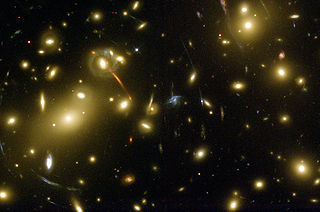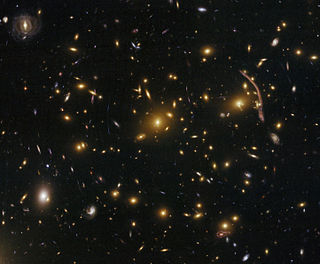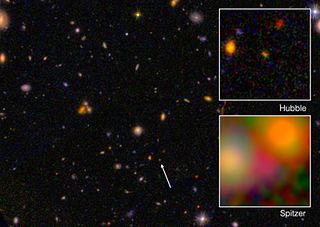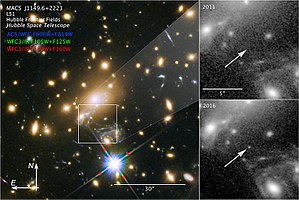The following are lists of stars. These are astronomical objects that spend some portion of their existence generating energy through thermonuclear fusion.

A gravitational lens is matter, such as a cluster of galaxies or a point particle, that bends light from a distant source as it travels toward an observer. The amount of gravitational lensing is described by Albert Einstein's general theory of relativity with much greater accuracy than Newtonian physics, which treats light as corpuscles travelling at the speed of light.

A galaxy cluster, or a cluster of galaxies, is a structure that consists of anywhere from hundreds to thousands of galaxies that are bound together by gravity, with typical masses ranging from 1014 to 1015 solar masses. They are the second-largest known gravitationally bound structures in the universe after some superclusters (of which only one, the Shapley Supercluster, is known to be bound). They were believed to be the largest known structures in the universe until the 1980s, when superclusters were discovered. One of the key features of clusters is the intracluster medium (ICM). The ICM consists of heated gas between the galaxies and has a peak temperature between 2–15 keV that is dependent on the total mass of the cluster. Galaxy clusters should not be confused with galactic clusters (also known as open clusters), which are star clusters within galaxies, or with globular clusters, which typically orbit galaxies. Small aggregates of galaxies are referred to as galaxy groups rather than clusters of galaxies. The galaxy groups and clusters can themselves cluster together to form superclusters.

Abell 2218 is a large cluster of galaxies over 2 billion light-years away in the constellation Draco.

The cosmic distance ladder is the succession of methods by which astronomers determine the distances to celestial objects. A direct distance measurement of an astronomical object is possible only for those objects that are "close enough" to Earth. The techniques for determining distances to more distant objects are all based on various measured correlations between methods that work at close distances and methods that work at larger distances. Several methods rely on a standard candle, which is an astronomical object that has a known luminosity.

The Einstein Cross is a gravitationally lensed quasar that sits directly behind the centre of the galaxy ZW 2237+030, called Huchra's Lens. Four images of the same distant quasar appear in the middle of the foreground galaxy due to strong gravitational lensing. This system was discovered by John Huchra and coworkers in 1985, although at the time they only detected that there was a quasar behind a galaxy based on differing redshifts and did not resolve the four separate images of the quasar.

Gravitational microlensing is an astronomical phenomenon due to the gravitational lens effect. It can be used to detect objects that range from the mass of a planet to the mass of a star, regardless of the light they emit. Typically, astronomers can only detect bright objects that emit much light (stars) or large objects that block background light. These objects make up only a minor portion of the mass of a galaxy. Microlensing allows the study of objects that emit little or no light.

Sjur Refsdal was a Norwegian astrophysicist, born in Oslo. He is best known for his pioneer work on gravitational lensing, including the Chang-Refsdal lens.

Abell 370 is a galaxy cluster located nearly 5 billion light-years away from the Earth, in the constellation Cetus. Its core is made up of several hundred galaxies. It was catalogued by George Abell, and is the most distant of the clusters he catalogued.
The Cloverleaf quasar is a bright, gravitationally lensed quasar.

MACS0647-JD is a galaxy with a redshift of about z = 10.7, equivalent to a light travel distance of 13.26 billion light-years. If the distance estimate is correct, it formed about 427 million years after the Big Bang.

The Cluster Lensing And Supernova survey with Hubble (CLASH) was a program on the Hubble Space Telescope to observe 25 massive galaxy clusters. CLASH was one of three programs selected in the first class of Hubble multi-cycle treasury programs, which were designed to tackle large questions unanswerable through normal observations. Observations for CLASH were conducted between November 2010 and July 2013. CLASH was led by principal investigator Marc Postman, and had a science team of over 40 researchers.

The galaxy cluster IRC 0218 hosts the most distant strong gravitational lensing galaxy currently known at a redshift of z = 1.62. The lens is one of the two brightest cluster galaxies and is lensing a background star-forming galaxy at a redshift of z = 2.26 into a bright arc and a faint counterimage. The lens was discovered through a combination of Hubble Space Telescope and Keck telescope imaging and spectroscopy. The discovery and subsequent analysis of the lens was published in the Astrophysical Journal Letters on June 23, 2014 by an international team of astronomers led by Dr. Kim-Vy Tran from Texas A&M University in College Station, Texas and team members Dr. Kenneth Wong and Dr. Sherry Suyu from the Academia Sinica Institute of Astronomy and Astrophysics in Taipei, Taiwan.

MACS J0416.1-2403 or MACS0416 abbreviated, is a cluster of galaxies at a redshift of z=0.397 with a mass 160 trillion times the mass of the Sun inside 200 kpc (650 kly). Its mass extends out to a radius of 950 kpc (3,100 kly) and was measured as 1.15 × 1015 solar masses. The system was discovered in images taken by the Hubble Space Telescope during the Massive Cluster Survey, MACS. This cluster causes gravitational lensing of distant galaxies producing multiple images. Based on the distribution of the multiple image copies, scientists have been able to deduce and map the distribution of dark matter. The images, released in 2014, were used in the Cluster Lensing And Supernova survey with Hubble (CLASH) to help scientists peer back in time at the early Universe and to discover the distribution of dark matter.

SN Refsdal is the first detected multiply-lensed supernova, visible within the field of the galaxy cluster MACS J1149+2223. It was named after Norwegian astrophysicist Sjur Refsdal, who, in 1964, first proposed using time-delayed images from a lensed supernova to study the expansion of the universe. The observations were made using the Hubble Space Telescope.

EGSY8p7 (EGSY-2008532660) is a distant galaxy in the constellation of Boötes, with a spectroscopic redshift of z = 8.68, a light travel distance of 13.2 billion light-years from Earth. Therefore, at an age of 13.2 billion years, it is observed as it existed 570 million years after the Big Bang, which occurred 13.8 billion years ago, using the W. M. Keck Observatory. In July 2015, EGSY8p7 was announced as the oldest and most-distant known object, surpassing the previous record holder, EGS-zs8-1, which was determined in May 2015 as the oldest and most distant object. In March 2016, Pascal Oesch, one of the discoverers of EGSY8p7, announced the discovery of GN-z11, an older and more distant galaxy.

GN-z11 is a high-redshift galaxy found in the constellation Ursa Major. It is among the farthest known galaxies from Earth ever discovered. The 2015 discovery was published in a 2016 paper headed by Pascal Oesch and Gabriel Brammer. Up until the discovery of JADES-GS-z13-0 in 2022 by the James Webb Space Telescope, GN-z11 was the oldest and most distant known galaxy yet identified in the observable universe, having a spectroscopic redshift of z = 10.957, which corresponds to a proper distance of approximately 32 billion light-years. Data published in 2024 established that the galaxy contains the most distant, and therefore earliest, black hole known in the universe.

WHL0137-LS, also known as Earendel, is a star in the constellation of Cetus. Discovered in 2022 by the Hubble Space Telescope, it is the earliest and most distant known star, at a comoving distance of 28 billion light-years. The previous furthest known star, MACS J1149 Lensed Star 1, also known as Icarus, at a comoving distance of 14.4 billion light-years, was discovered by Hubble in 2018. Stars like Earendel can be observed at cosmological distances thanks to the large magnification factors involved, that can exceed 1000. Other stars have been observed through this technique, such as Godzilla.

Webb's First Deep Field is the first operational image taken by the James Webb Space Telescope (JWST). The deep-field photograph, which covers a tiny area of sky visible from the Southern Hemisphere, is centered on SMACS 0723, a galaxy cluster in the constellation of Volans. Thousands of galaxies are visible in the image, some as old as 13 billion years. The image is the highest-resolution image of the early universe ever taken. Captured by the telescope's Near-Infrared Camera (NIRCam), the image was revealed to the public by NASA on 11 July 2022.


















